
MAY CONTAIN NUTS

Search Shorpy
SHORPY ART

Framed or unframed, desk size to sofa size, printed by us in Arizona and Alabama since 2007. Explore now.
Join and Share
Ad-Free Shorpy
Shorpy is funded by you. Patreon contributors get an ad-free experience.
Learn more.

Recent comments
- Button It Up
- And with an eye on the time ...
- Working in an enclosed ashtray
- Rear View Mirror?
- Tobacco cam
- Basic fact I learned only later in life
- Put a Lid on it!
- Pinstripes in the Tower
- Sound enhancement
- 3438 in '38
- Second Career
- Their days are numbered
- Only the Sensor
- Train control mechanism
- Rarest of the Rare?? & Classy 3400 Class
- Control Mechanism
- Those standpipes
- Wrenches
- International D-40 I believe
- Job prospects
- You had me at Train
- Land of the free
- Broad-Exchange Bldg
- Parking innovation
- The old block
- "Peck turned a sweet propeller"
- National Bank Building
- Notch shot
- Straight ahead (right, left, left, right)
- Ship lifespans
Member Photos
The Shorpy
Printporium
Printporium
Search Shorpy
Search results -- 30 results per page
- Inner Harbor: 1906
- ...
Plant Line to the Provinces! one night at sea to a foreign land!
a clipping from the Boston Evening ... Posted by Dave - 03/04/2016 - 10:40am -
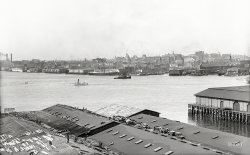
- Lux Luna: 1905
- Coney Island, New York, circa 1905. "Luna Park at night." Panorama made from three 8x10 glass negatives, previously seen here ... Posted by Dave - 04/24/2019 - 11:19am -

- Headed back to Dallas via the Grand Canyon
- ... got there right at day break. Hours through the desert at night was brutal in trying to stay awake (and find open gas stations). We'd ... Posted by Zone47 - 05/18/2022 - 8:12am -
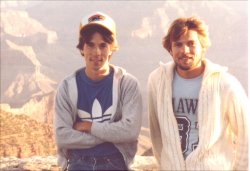
- Moldy Manse: 1937
- ... of Orleans and Dauphine. Then, after a dark and stormy night, the cottage was found empty with a newly dug grave in the garden along ... Posted by Dave - 11/07/2013 - 2:24pm -
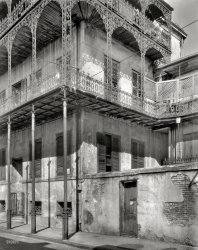
- City Terminal: 1941
- ... is aligned to prohibit entrance to the flagged track. At night, a blue lantern serves the same purpose as the flag. Only the person, or ... Posted by Dave - 01/31/2020 - 9:25pm -
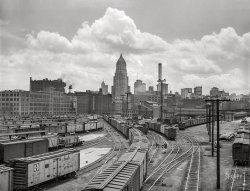
- The Road to Mecca: 1923
- ... DoninVa
Friday: With my fez still in the air, after a night's sleep I realize we are talking apples and oranges. While all Shriners ... Posted by Dave - 09/12/2011 - 12:09pm -
![The Road to Mecca: 1923 "Almas director." Officials of Almas, the Washington D.C., Masonic temple, at the Shriners Convention of June 1923, which hosted a quarter-million delegates from lodges and temples across the United States. Imperial Potentate James McCandless and President Warren Harding, himself a Master Mason, were among the dignitaries present for a week of parades along Pennsylvania Avenue, which was strung with thousands of electric lights and rechristened the "Road to Mecca" at a time when interest in fraternal organizations was at its peak. View full size.
Hats off to ya...This image may be indicative of an era when people had a lot more free time on their hands.
Counting ShrinersAs a Shriner I have often heard of our membership number woes. The peak of membership, if I recall correctly, was actually after WWII, but in the 1960s the decline began with the deaths of men in their 60s and 70s. The current concern about membership is rooted in our support of the 22 Shriners Hospitals for Children, which provide orthopedic and burn care absolutely free of charge. Each year we have fewer men to assist in the fund raising efforts.
Also, I doubt 250,000 delegates showed up for the convention; that was probably the number of Shriners nationwide in 1923.
[Masonic membership at its peak in the United States was around 4 million. The population of Washington was expected to grow from 437,000 to over 700,000 during the week of the Shrine convention in June 1923, according to the New York Times. The Washington Post put the number of guests at 500,000. - Dave]
Dave, I raise my fez to salute your always excellent research abilities. - DoninVa
Friday: With my fez still in the air, after a night's sleep I realize we are talking apples and oranges. While all Shriners are Masons, not all Masons are Shriners. I was considering Shrine membership, not Lodge membership; by 1930 there were 600,000 Shriners.
MasonsTrue. They had just reached the point where you didn't need to work 18 hours a day just to survive, the country was in decent shape economically, and kids' sporting events, dance recitals and all of the other stuff that occupies people's lives had not yet been invented.
However, back then, you had to seek activities for your leisure. Today a lot of folks turn on the TV and crack a cold one because leisure is handed to us via satellite. That is definitely a factor in Masonic as well as other existing fraternal organizations decline in numbers. The old-timers die off, younger folks have other outlets.
Fraternal OrganizationsHats Off you are right about more free time for many people. The Lodge Hall was a more respectable place than a local tavern, especially during Prohibition. The camaraderie was another factor and there were some good works involved. I think it started to unravel after WWII.
Harding the MasonThe Harding biography "The Shadow of Blooming Grove" covers the subject of W.G.'s masonic aspirations in great detail. He was actually denied entry into the masonic order until later in his life, after his first term as a congressman, due to the rumors around Ohio that he was of Negro ancestry, an accusation used by Harding's enemies in those race-conscious times. As his prestige rose and he entered the Senate he basically forced his way into the order and was shuffled quickly through its ranks to the highest levels.
(The Gallery, D.C., Natl Photo)](https://www.shorpy.com/files/images/08830u.thumbnail.jpg)
- Jr. O.U.A.M.: 1938
- ... look of things, no longer "meets each 1st & 3rd Sat night." Photo by John Vachon. View full size.
Still a going concern. ... Posted by Dave - 11/08/2012 - 11:48am -
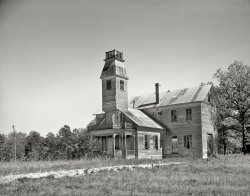
- Bus Kennel: 1943
- ... neon sign is real neat. I would like to have seen it at night.
Indianapolis Traction Terminal The buses are resting in the shade ... Posted by Dave - 02/25/2017 - 1:25pm -
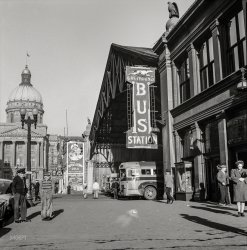
- Louisiana Noir: 1932
- ... "Louisiana State Capitol at Baton Rouge. Tower lights at night. Gov. O.K. Allen. Weiss, Dreyfous & Seiferth, client." Where Huey ... Posted by Dave - 02/10/2014 - 4:05pm -
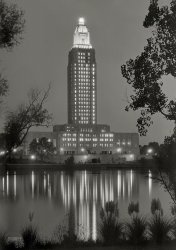
- New Year's Eve 1956
- ... my mother always told me that December 31, 1956, was the night I was conceived. Now I know what was going on and what people were doing! ... Posted by tterrace - 09/29/2011 - 7:12pm -
![New Year's Eve 1956 December 31, 1956 (or January 1, 1957). A party my brother, then 19, went to. Other than recognizing a couple family friends, that's all I know about this Ektachrome slide. View full size.
Village People"Photo by Patrick McGoohan."
SphereThanks, No. 6; I was trying to come up with some snappy remark about the pink balloon, but I gave up.
Conception DayThis is truly wild: my mother always told me that December 31, 1956, was the night I was conceived. Now I know what was going on and what people were doing!
Shorpy Countdown!Hey Dave, where's the Shorpy Top 20 Images Countdown of 2008?! My votes go to the 1925 office Christmas party and the Krazy Kat series.
[This year we have the "user-customizable countdown." Whichever photo you like the most wins! - Dave]
(ShorpyBlog, Member Gallery, New Year, tterrapix)](https://www.shorpy.com/files/images/ny1956_0.thumbnail.jpg)
- Trick or Treat: 1948
- Oct. 31, 1948. "Bond's, New York City. Night exterior, Fifth Avenue." Headless on Halloween! Large-format negative by ... Posted by Dave - 05/14/2015 - 9:08pm -
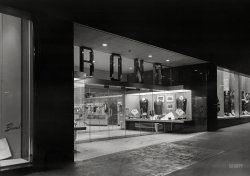
- Light Industry: 1941
- January 1941. "Textile mill working all night in Lowell, Massachusetts." Acetate negative by Jack Delano for the Farm ... Posted by Dave - 11/15/2018 - 8:20pm -
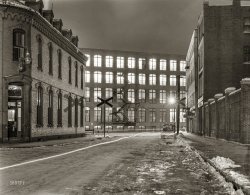
- Hotel Rainbow: 1941
- ...
No Vacancy Except for Ghosts and Spirits of the Night.
Vacancy There's always room under the rainbow.
First National ... Posted by Dave - 02/14/2020 - 10:55am -
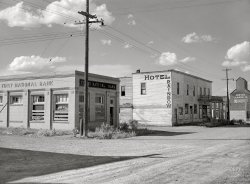
- Poor Guy: 1939
- ... block over from us for many years, used to go to sleep at night listening to it and the trains that went past the house. May Avenue is ... Posted by Dave - 05/22/2018 - 5:44pm -
![Poor Guy: 1939 July 1939. "Bed with roof over it in May Avenue camp, Oklahoma City." Photo by Russell Lee for the Farm Security Administration. View full size.
He May Not Be Down on His LuckHe's wearing a Cities Service patch on what looks like a uniform that is in overall decent shape. Probably has a job.
Interesting history of the company:
https://en.wikipedia.org/wiki/Citgo
[People sleeping outdoors on trash are down on their luck! - Dave]
He may be down on his luck,But he's sporting a pair of well-used Chuck Taylors.
AirbnbAir, Bed & Board.
May AvenueI think many of the people of Oklahoma City have forgotten how rough it was here in those days. I wasn't born then, about 15 years later, but I heard a lot about it from my family. My great grandparents even had a land grant from the Run. The house I grew up in on the south side of the city had a working oil well one block over from us for many years, used to go to sleep at night listening to it and the trains that went past the house. May Avenue is very different now, of course.
(The Gallery, Great Depression, OKC, Russell Lee)](https://www.shorpy.com/files/images/SHORPY-8b22619a.thumbnail.jpg)
- Car Haven: 1963
- ... silly reason Google Street View shows this in the dark of night). That tall building at the right is the New Haven Railroad office ... Posted by Dave - 03/17/2018 - 12:28pm -
![Car Haven: 1963 1963. "Parking garage, New Haven, Connecticut. Interior looking down ramp. Paul Rudolph, architect." Photo by Ezra Stoller. Paul Rudolph Collection, Library of Congress. View full size.
Car heavenSuch a highly evocative photograph. The dramatic lighting on the car on the left is downright cinematic, and the detail in the concrete of the formwork is endlessly fascinating, so wood-like in appearance. The swooping form of the overhead structures is lovely, and captured to maximum effect with the camera angle. Finally, those are the cars that populated the environment of my 6-year-old self, in that year, and seeing them casually parked and coming up the ramp is like some time-travel dream. Thank you, Ezra Stoller, whoever you are. You remind me in the best way of Samuel Gottscho.
[His obituary. - Dave]
Mr. Stoller was not merely a documenter but also an interpreter of buildings, translating an architect's three-dimensional vision into two-dimensional abstract compositions that had a sweeping beauty of their own. Famous for his ability to capture a building from just the right angle and in just the right light, he was often commissioned by the world's leading architects, who spoke, in hopeful tones, of having their creations "Stollerized."
All new all over againBetween these two Chevys, '54 on left and '59 on right, are huge differences in design (compare the hoods), and in between those were three vastly different designs, the '55-56, then classic '57 and my fav of all, the '58. Each very different in design and mechanicals. Those were the days of great new model rollouts.
[The "Tri-Five" Chevrolets of 1955-56-57 were basically the same car with different sheet metal. - Dave]
Little detailsA couple of things are revealed about both Chevies in the photo. The '54 is a stick shift otherwise you'd see the PowerGlide gear shift pointing at the 1:00 position behind the steering wheel. The '59 is an Impala by trim and a 283 by engine choice because of the "V" on the hood--a 348 would have cross-flags above the "V". The '55 Hudson and VW Bug say "me too"!
[The “'55 Hudson” is a 1957 Rambler. -tterrace]
Still ThereThis looks like the Temple street garage in New Haven CT (for some silly reason Google Street View shows this in the dark of night). That tall building at the right is the New Haven Railroad office building, now a board of education office building.
Function and Form and FlairThe Temple Street Garage of New Haven, a fine example of urban architecture that deftly blends function and form. Architect Paul Rudolph said, "I wanted to make a building which said it dealt with cars and movemement. I wanted there to be no doubt that this is a parking garage."
While most parking structures are unremarkable stacks of concrete slabs, Rudolph molded into this building gracious curves that invoke the motions of vehicles on superhighways.
Stacked Board formworkBrutalism at its "finest". Note that the concrete is given its texture, rhythm and direction from the naked, unfinished boards stacked together as a concrete form. The wet concrete flows up against the boards and takes on the grain, not-holes and records the spaces between the planks.
He could have used plywood forms, or smooth, non-textured formwork. The garage would have had a vastly different feel from those techniques. He also uses the formwork to create flat ceilings, arched barrel vaults and arched beams that go from column to column, as if this were a great medieval cathedral. Well, it was america in the 1950s and what other use did we have for religious architecture? Can we stand this stuff today?
(Cars, Trucks, Buses)](https://www.shorpy.com/files/images/SHORPY-19145u.thumbnail.jpg)
- Clinton L. King
- ... sax; Paul Bailey, drums, played an engagement Thursday night at Smalley's Lakeside Pavilion, Otsego Lake, Cooperstown. It is ... day, has an option on further work at Smalley's. Friday night they furnished the music at the I.O.O.F. sponsored clam bake at the ditto ... Posted by Sharon King - 09/20/2011 - 8:28pm -
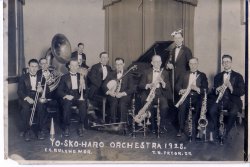
- Sunset Lodge: 1918
- ... High beam I just wonder who had to climb a ladder every night to light the little lantern over their sign? Or maybe they just lit it on ... Posted by Dave - 11/11/2014 - 1:35pm -
![Sunset Lodge: 1918 The Pacific Northwest in 1918. "Kissel Military Highway Scout Kar at Sunset Lodge." Our first look at what seems to have been a Kissel Kar promotion tied to the war effort. 5x7 glass negative by Christopher Helin. View full size.
High beamI just wonder who had to climb a ladder every night to light the little lantern over their sign? Or maybe they just lit it on special occasions.
[Maybe they had a pole. With a hook. - Dave]
Porcelain welcomeNothing says "Howdy stranger!" better than a chamber pot waiting by the front steps.
Kissel Kar in camouflageThis is the same car and driver shown here. That separate link carries fascinating information about this patriotic stunt, including a couple of captions from the newspapers of the day. The ladies, who do not appear in that other picture, must have been members of the staff at Sunset Lounge posing for a picture.
(The Gallery, Cars, Trucks, Buses, Chris Helin, WWI)](https://www.shorpy.com/files/images/SHORPY-141111-0004B.thumbnail.jpg)
- The Goblins Next Door: 1911
- ... in northern New Jersey. They had "Ragamuffin Day" the night before Thanksgiving. The preferred treats were nuts and apples.
When ... Posted by Dave - 09/11/2011 - 9:28pm -
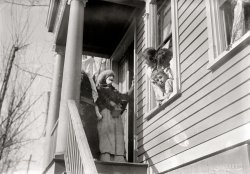
- Wash Ave.: 1906
- ... lots and isolated office buildings now. It's desolate at night. I doubt there's a single building in this picture left standing. I like ... Posted by Dave - 08/09/2012 - 7:15pm -
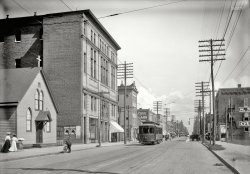
- Coffee Shop Cadillac: 1964
- ... "St. Clairs Coffee Shop and Mosher Record Store, Boston, night." Neon with a side of tailfin. 35mm negative, photographer unknown. ... Posted by Dave - 07/20/2015 - 10:44am -
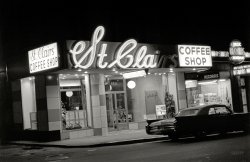
- Reflections on a Stop Sign: 1936
- ... inexpensive red paint. The need to reflect headlights for night use led to extensive use of small round "button" reflectors inside the ... Posted by Dave - 01/22/2014 - 9:22am -
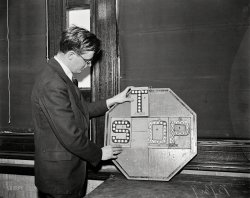
- 1948 Chevrolet Fleetline
- ... headlights did for seeing where the heck you were going at night. But they too added coolnicity. That amber Indian face on the Pontiac ... Posted by Roland B. - 09/01/2010 - 8:03am -

- Imperial Hotel: 1940
- ... off the shelf at the grocery store and played cards at night. Went to a blind auction at the town hall.
A wonderful weekend. I ... Posted by Dave - 04/30/2020 - 2:09pm -
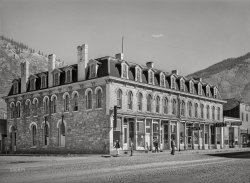
- An Essential Part: 1939
- ... mill in Canal Flats, near Cranbrook, B.C. This was at night, and the lower portions of the burner were glowing red hot, and sparks ... Posted by Dave - 02/20/2019 - 7:05pm -
![An Essential Part: 1939 August 1939. "Pelican Bay Lumber Company. The burner is as characteristic of the Northwest landscape as grain elevators are to the Plains. There are many types of variations. It is an essential part of the sawmill. Disposes of sawdust and waste. Near Klamath Falls, Oregon." Photo by Dorothea Lange. View full size.
Usually wigwam shaped.Most of these waste burners, at least in the Northwest, had flared sides (Google "wigwam burner.") Many of these rusty relics are still in place, although no longer used for reasons of air pollution. In addition, the scraps and sawdust from a lumber mill are no longer considered to be waste. They make up useful biomass which can be used for construction materials, mulch, fuel, etc.
This impressive erection must have been an unusual case.
[In other words, not shaped like a shuttlecock. - Dave]
NSFWIs this the new Shorpy?
Beehive BurnersIn British Columbia these were called beehive burners, since most of them had that shape. The last one I saw in operation was in the 1990s at a lumber mill in Canal Flats, near Cranbrook, B.C. This was at night, and the lower portions of the burner were glowing red hot, and sparks and cinders were flying out of the screen at the top into the dark sky. It was quite dramatic. The mill is still there, but the beehive burner is long gone. The City of New Westminster, near Vancouver, interviewed a worker who maintained a beehive burner here, and CBC television news covered an artist who painted them here.
There's Gold In Them There Sawdust Now.When I worked for Georgia Pacific the sawdust was collected as logs and plywood panels were cut to size and sucked outside to a waiting freight car to be sent someplace where there must have been a deficit of sawdust.
Unused wood, bark and damaged panels was also processed in a grinder and reduced to splinters before being sent off. There was very little waste generated.
I always imagined the sawdust was sent to Pringles and combined with potato mush to be made into Pine Cone Delight Potato Chips.
Off The Grid A sawdust burner is part of the plot in the C. J. Box novel "The Disappeared".
(The Gallery, Dorothea Lange, Industry & Public Works)](https://www.shorpy.com/files/images/SHORPY-8b34541a.thumbnail.jpg)
- College Ices: 1908
- ... to make a "college ice" as a treat for us kids on a Friday night. Vanilla ice cream, Hershey's chocolate syrup and whatever fruit was ... Posted by Dave - 11/17/2013 - 1:33pm -
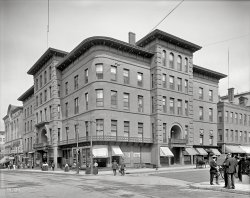
- Private Hospital: 1939
- ... successfully using Edison's invention for lighting up the night, we are all in for a shock come January. The bulbs that now sell for ... Posted by Dave - 05/17/2011 - 11:30pm -
![Private Hospital: 1939 January 1939. Herrin, Illinois. "Operating room at Herrin Hospital (private)." 35mm nitrate negative by Arthur Rothstein. View full size.
Now fetching $1,100.00 on FleaBayOr at some hipster antique shop near you.
How many 25 watt bulbs does it take to perform an appendectomy? I hope the maid got all the dust off those fixtures!
No More Incandescent BulbsAfter more than 100 years of successfully using Edison's invention for lighting up the night, we are all in for a shock come January. The bulbs that now sell for about 25 cents each will no longer be available. Our alternate choices will be costing us anywhere from $5 each to $50 each. Having personally used fluorescent lights occasionally, I found it to be a hassle and hazard to dispose of them (mercury and gas) and a few burned out within a couple of months. The LED's give a different light and cost more. The "halogen" bulbs get as hot as 800 degrees and start fires. This issue will come as a surprise to many low income people who can barely buy food and/or pay rent who will not have the money to replace $50 or even $5 lightbulbs. Just the facts ma'am, just the facts.
[Mistaken notions vs. the facts. - Dave]
More than 25 wattsJudging from the physical size, these are 150 watts or larger, as appropriate for the application. Very large incandescents are hard to come by nowadays, having been supplanted by halogen in this type of environment, and fluorescent or HID elsewhere.
And no, one need not spend $5 for a compact fluorescent. At my local store, I can buy 60W incandescents for 32 cents each, vs. $2 each for a 14W CFL (four-packs). Even if the CFL only lasts 2,000 hours rather than 10,000, it will still save $10 in electricity. And yes, I have metered it. The math doesn't lie.
(The Gallery, Arthur Rothstein, Medicine)](https://www.shorpy.com/files/images/8a10480a.thumbnail.jpg)
- Flower Power: 1925
- ... to the public from 9 o'clock in the morning until 9 at night.
Wise Byrnes, head of the greenhouses, will have charge. “It ... Posted by Dave - 03/02/2014 - 8:27pm -
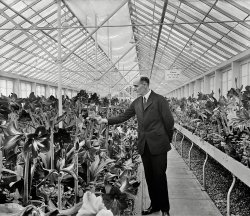
- Almost Done: 1911
- ... to me. - Dave]
I'd like to see this scene at night illuminated by the hanging lamp!
Well preserved City Hall (and the ... Posted by Dave - 11/08/2019 - 5:16pm -
![Almost Done: 1911 Portland, Maine, circa 1911. "New City Hall, Congress Street." Photobomb by our old friend the carbon arc lamp. 8x10 inch glass negative, Detroit Publishing Company. View full size.
A Dead Ringer for NYCThis building was obviously inspired by the design of New York's City Hall, designed by Joseph Mangin and John McComb, Jr. (winners of the 1802 competition) and built 1803-1812. The relation of the side wings to the central block and the form of the tower are quite close to the original. The section at the back right is different nonetheless.
Odd architecture?What are thos walls at the top? Very strange to see them just standing there. What is their purpose, or the style they embody?
[They look like chimneys to me. - Dave]
I'd like to see this scene at night illuminated by the hanging lamp!
Well preservedCity Hall (and the building to its left) look almost the same as the original picture. It's nice to see they got the clocks installed.
+97Below is the same view from October of 2008.
(The Gallery, DPC)](https://www.shorpy.com/files/images/SHORPY-4a24259a.thumbnail.jpg)
- Fasten Your Seat Belts
- ... and a line of light installations to guide the planes at night. On occasional Sunday afternoons we would go down there, pull off the ... Posted by Barrydale - 09/07/2012 - 7:42pm -

- A Little Cottage: 1938
- ... all winter if possible, with bricks radiating heat all night as the fire died down to embers, to be rejuvenated ASAP in the morning. ... Posted by Dave - 09/17/2017 - 12:13pm -
![A Little Cottage: 1938 1938. "Thebideau (Thibodaux?) cabin, Franklin vic., St. Mary Parish, Louisiana. Related name: Mrs. Streva." Photo: Frances Benjamin Johnston. View full size.
Alternate spellingsThis surname could also be spelt Thibedeaux or in several other ways. The first "e" is sometimes rendered as an "i," "a," or "o."
As an amateur genealogist, I am often confounded by such alternate spellings, which reflect variations in dialect across Medieval and Renaissance France as well as later modifications made in the New World.
Interesting DesignThat porch seems to double as an open-air hallway, giving access to all the rooms. Was that a standard design in those parts, back in the day?
Thibodeauis the usual spelling here in Nova Scotia, from whence the Acadians were expelled by the British in 1755. Many ended up in Louisiana. From our National Post newspaper telling about a Thibodeau reunion here in 2013:
"Don Thibodeaux, a former accountant from Baton Rouge, La., (Cajuns — Acadians who migrated to Louisiana after the deportation — add an “x” to the surname), traced his line to a spot near Moncton, N.B., only to discover it’s now a bowling alley parking lot."
Note that after much wandering, many Acadians were allowed to return to Nova Scotia by the British, who gave some of them land 100 miles away from the fertile valley they had lived before the deportation. My sister-in-law hails from Clare. There is a lively tourism between Cajun country and the Maritime provinces of Canada due to a shared past.
Plein Air!Porlock, yup: that is a typical Deep South feature of southern homes built way back BAC (before a/c), to allow fuller ventilation of the rooms. Also typical was a FULL hallway right through the house (a dogtrot), as shown in the below floor plan. The below plan also has the more typical southern arrangement of chimneys on the outer walls, so that the heat from them radiates or escapes out of the house, while the Shorpy example has the chimney in the center. In the north typically, the chimney would either be in the center, or it would cover an entire end wall. In both cases, the chimney would be waaay more massive than structurally necessary to retain heat. The fire would be kept going all winter if possible, with bricks radiating heat all night as the fire died down to embers, to be rejuvenated ASAP in the morning.
ThibodeauxOne of the greatest Cajun names ever [of course, I'm a little biased]. I'm a descendant of Pierre Thibodeaux, first settler of that name in Louisiana in the late 1750s.
(The Gallery, F.B. Johnston)](https://www.shorpy.com/files/images/SHORPY-01600a.thumbnail.jpg)























